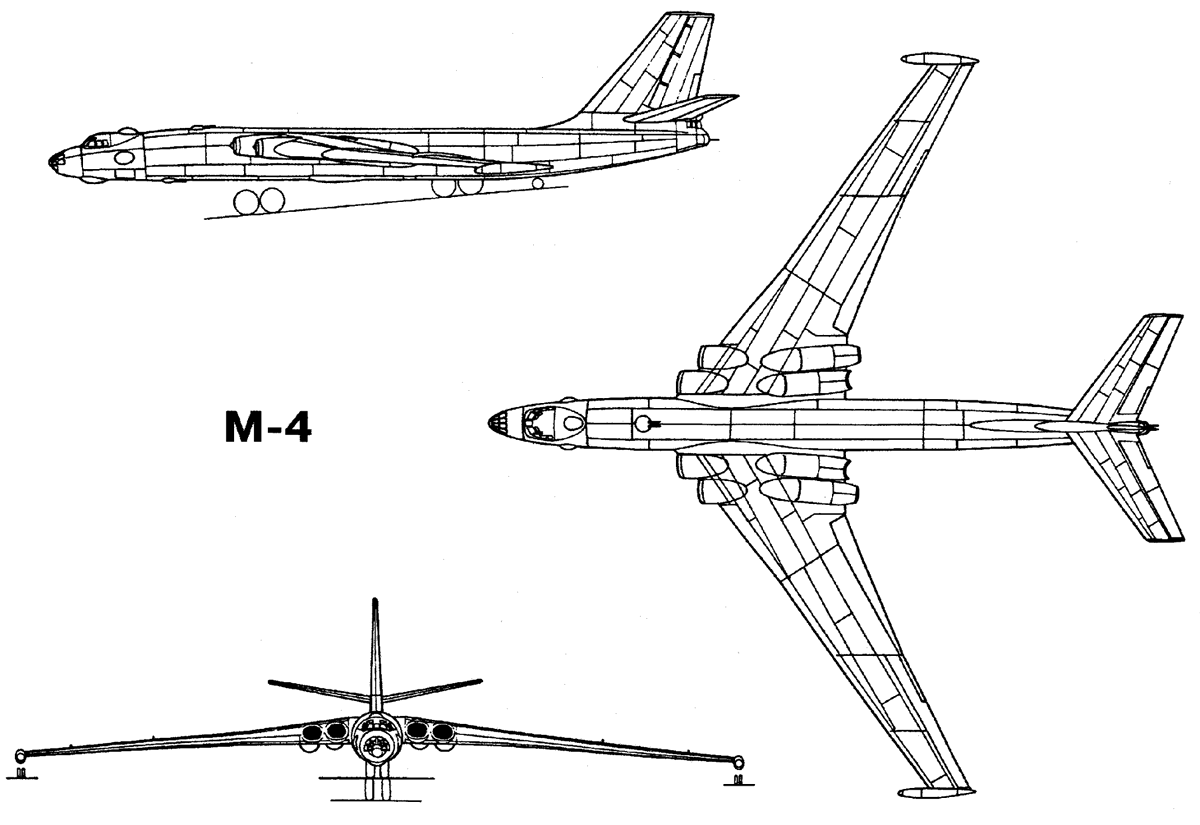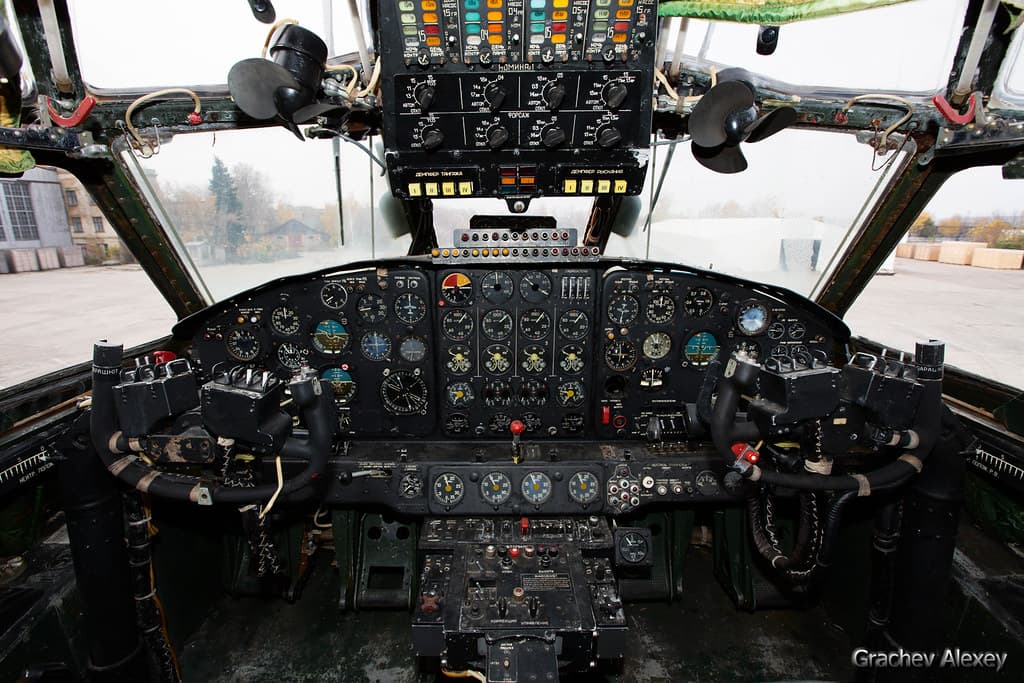A brief preface
Hello and welcome to Heavy Bomber March suggestion #5! This month I’m cranking out suggestions for heavy bombers. Introducing an oft-overlooked Soviet heavyweight, the Mysischev M-4 Molot!
Overview
The Myasischev M-4 Molot is a Soviet four-engined jet strategic bomber. It is arguably the first jet strategic bomber to enter service, as it was the first such aircraft with truly intercontinental range. Early production M-4s were powered by AM-3D turbojets, while later aircraft featured RD-3Ms and these gradually phased out the AM-3Ds via refits. For that reason this suggestion will focus on the RD-3M-500A-powered M-4s.
- Yes
- No
History
Expand
Origins
Soon after the Tu-4 entered service, it was deemed obsolete. It lacked the range to reach targets in the US and was too slow to outrun the new generation of jet fighters entering service. To replace the Tu-4, Tupolev developed the Tu-80 and Tu-85, both based on the Tu-4 but with greatly improved performance. However, these two aircraft were still powered by conventional piston engines, resulting in unsatisfactory performance. So in 1951, Tupolev and recently reformed Myasischev were each tasked with designing next-generation bombers, to fly no later than December 1952, with the two competing and the superior design entering service. Combat experience in Korea had shown the B-29 was all but helpless against jet-powered MiG-15s, so both Tupolev and Myasischev designs would need to change away from from piston engines. Tupolev would base their bid off the Tu-85, adding swept wings and a turboprop powerplant, creating the Tu-95. Myasischev meanwhile would aim for higher performance, with an all-new aircraft also featuring swept wings and powered by four massive AM-3 turbojets.
Troubled Development
Myasischev’s bomber was at a disadvantage from the start. OKB-482 Myasischev had been dismantled in 1946 and only reinstated in 1951 for this project, Vladimir Myasischev working for the Moscow Aviation Institute at the time. This meant that before work could even really begin on the bomber itself the design team would need rebuilt from the ground up. To make matters worse, Mikhail Kroonichev was still Minister of Aircraft Industry and was just as antagonistic towards Myasischev as he had been in 1946 when he order OBK-482 dissolved.
Nonetheless, work proceeded at record pace, with the basic design for what was now designated the 1M finished in a mere four months. Eight designs were developed, largely differing in wing design and propulsion. Of these eight, the selected design would have a high-aspect kinked swept wing, with moderately swept control surfaces, and quad AM-3 turbojets embedded in the inner wing. A unique feature of the 1M design was its bicycle landing gear- there were two main sets of landing gear, both inline in the fuselage. Stability was accounted for via smaller secondary gear sets on the wingtips. This allowed for a lighter and smaller design, though it would also result in persistent control issues on the ground. The full-scale wooden mockup was completed in October 1951. Armament was to consist of two nuclear bombs or 24,000kg of conventional bombs, with a defensive suite of three twin 23mm turrets.
It was the unusual gear arrangement that took the longest to evaluate. While such a configuration had been used before, never on such a large aircraft and never on a mass-produced aircraft. A series of other aircraft, most notably the I-215D and several Tu-4s, were used as testbeds for the gear arrangement between 1951 and 1952.
Production of the first prototype initiated in October 1951, even as the design continued to be refined. Final design was finished only in April 1952, with the prototype rolling out in November.
Prototypes and Evaluation
First flgiht of the Myasischev 1M occurred on 20th January 1952. While later than originally required, it was nonetheless an incredible achievement to go from the establishment of the deign bureau to the first flight of a world-class jet bomber in less than 22 months. This flight lasted only 10 minutes as the aircraft’s rudder jerked suddenly after takeoff. After a second flight with the same result, the issue (a simple crossed wire) was discovered and resolved, and further flights revealed only more minor and common issues. The second prototype was completed in December 1953, with the two finishing flight testing in April 1954. The second prototype differed from the first in larger inboard wings, higher fuel capacity, and a number of other minor changes and would serve as the production standard. This airframe had its own issues- the first prototype had been 25 tonnes overweight, resulting in weight being saved wherever possible on the second prototype- even at the detriment of safety, almost resulting in the loss of the aircraft and crew on the 14th flight when the the too-thin elevators blew off mid-flight. This and other issues during evaluation meant that state trials were delayed until April 1954- or rather, May 1954 as the first prototype was selected to fly at the May Day parade in Moscow, escorted by two pairs of MiG-17s and followed by the first 9 Tu-16s. While Soviet aircraft were typically kept secret, it was decided to demonstrate the 1M to the world as a show of strength against the West in response to the development of the American B-52.
Into Production
The 1M fell short of requirements in every metric. In particular, it was far off the required range of 12,000km, only capable of 9,800km. However, with the crash of the Tu-95/1 prototype and the increasing dominance of Western bombers, the Soviets had no other choice than to order the 1M into service in November 1954 as the M-4, with the AM-3 engines to undergo an upgrade as soon as possible to acheive statisfactory performance and the Tu-95’s development to continue, even though it was originally planned to only produce one of the two designs. Only two production aircraft were completed in 1954, this was followed by nine in 1955, and finally 20 in 1956. Starting at some point in 1955, the AM-3D was replaced by an upgraded model, the RD-3M-200. This engine provided more thrust and also a higher efficiency, bringing the M-4 up to its required specifications. The RD-3M-200 was followed by the RD-3M-500A with increased reliability, requiring an overhaul every 500 flight-hours instead of 200.
The M-4 would officially enter service in early 1955, though it only completed final acceptance trials in mid-1956 and continued to see tests until 1958.
In service, the M-4 proved to be an unforgiving aircraft. Its bicycle gear layout had a unique takeoff procedure compared to tricycle gears, with little required input from the pilot. However, if the pilot were to pull back on the stick as in a traditional aircraft, the M-4 had a disastrous tendency to launch the nose upwards, stall, and promptly slam back down. The gear were also prone to collapse and would often fail to retract or extend, and the electrical and hydraulic systems were unreliable. Even when nothing was broken, flying the M-4 was a miserable experience. To save weight, the M-4 lacked any significant provisions for crew comfort, not even a toilet, and cabin temperature control was practically non-existent, resulting in scorching heat at low altitudes and freezing (literally subzero) temperatures at altitude, this causing many a Molot crew to become sick.
The M-4 never saw active combat. They were divided into two squadrons, the 201st TBAD in the arctic and the 73rd TBAD in the far east. Both would run frequent harassment missions, probing the defenses of NATO and NATO-allied fleets and skirting restricted airspace. Had war broken out, the M-4s would have each carried a single nuclear weapon and targeted industrial areas, with lighter aircraft taking out smaller targets. These would likely have been one-way missions- the M-4 was ill-equipped to evade SAMs and modern jet interceptors, and even on a successful mission the aircraft would be pushing their maximum range.
Further developments
The M-4 saw considerable further development. The majority of these aircraft belonged to the 3M family, which will be described elsewhere (hint, hint). For the M-4 specifically, the main subsequent model was the M-4-2. This was an unarmed refueling aircraft. Starting in 1958, all surviving M-4s were converted to this standard to support the entering fleet of 3Ms.
Beyond the M-4-2 there were a few interesting paper designs based on the M-4. The first was the M-4P, a passenger aircraft, and similar M-4T military transport aircraft. The 2M was an improved bomber powered by AM-5 engines in underwing pods- this wasn’t produced due to the engines being unavailable in quantity. Finally, and not quite a specific variant, but one M-4 was modified to evaluate a variety of armaments including guided bombs, torpedoes, and mines. This proved unsuccessful so these weapons were not included in the M-4’s weapon selection.
Specifications
Expand
Airframe
Length: 44.6m
Span: 50.5m
Height: 11.5m
Wing Area: 326.4m^2
Empty Weight: 80,000kg
Loaded Weight: 140,000kg
MTOW: 184,500kg
Crew: 8
Propulsion
4x RD-3M-500A turbojet
Max Thrust: 93.20kN (each)
Max Thrust, 2 min WEP: 104.06kN (each)
Max Total Thrust, WEP: 416.26kN
Max TWR: 0.53
CO2 extinguishers
Internal Fuel: 123,600L in 20 self-sealing tanks
Unknown JATO pods
Flight Performance
Maximum Speed (high alt): 947km/h
Maximum Speed: Ma 0.9
Max Overload: 2.7g
Service Ceiling: 11,000m
Armament
Defensive:
2x 23mm AM-23 cannon, dorsal turret
300rpg
690m/s
2,600rpm (combined)
360 degree traverse
-3/+80 degrees elevation
2x 23mm AM-23 cannon, ventral turret
300rpg
690m/s
2,600rpm (combined)
360 degree traverse
-80/+3 degrees elevation
2x 23mm AM-23 cannon, tail turret
400rpg
690m/s
2,600rpm (combined)
+/-70 degree traverse
-40/+60 degrees elevation
Offensive:
2x FAB-9000M54- 18,000kg total
4x BrAB-6000- 24,000kg total
2x FAB-5000M54- 10,000kg total
6x FAB-3000M54- 18,000kg total
6x BrAB-3000- 18,000kg
28x FAB-500M54- 14,000kg total
52x FAB-250M46, M54- 13,000kg total
52x FAB-100M43- 5,200kg total
*nominal weights
Avionics
RPB-4 radar bombing system
PRS-1 gun radar (tail turret)
The M-4 in-game
Expand
The M-4 would be a beast of a bomber. With a higher payload and better flight performance than the Tu-95M and substantially larger than the Tu-16, the M-4 would be truly an end-line strategic bomber rivalled only by the YB-60 and 3M.
Gallery
Expand
First public look at the M-4 at May Day 1954. Note the lack of trailing edge kinks on the first prototype here
Several M-4s and a Tu-4


Inside the cockpit
The unique gear system (on an M-4-2)

3 view drawings

Landing
Sources
Expand
“Myasischev M-4 and 3M, the First Soviet Strategic Jet Bomber”- Yefim Gordon and Dmitriy Komissarov
Myasishchev M-4 / 3M "Bison" & M-50 "Bounder"
M-4 / Mya-4 / 2M, Myasishchev 'Bison' - Russian and Soviet Nuclear Forces
Уголок неба ¦ Мясищев М-4




